The Archos 101 XS Review: Prettier, Faster, So Much Better
by Jason Inofuentes on August 22, 2012 12:15 PM ESTPeformance
Archos has backed off the "World's Fastest" claims of the marketing for the G9 Turbos for this campaign. If they'd made the claim again there’d be some evidence to suggest it wouldn’t be too far afield. We may not have had high hopes for the OMAP 4470 as a performance part, seeing it more as a place holder for Windows RT until an OMAP 5 part was ready, but it turns out it can be a bit of a scorcher.
At this point, we’ve covered OMAP 4 for what seems like an absurdly long time. Indeed, it’s been over a year since Brian published this, an architectural overview of the OMAP 4470 we’re looking at today. TI has long been a proponent of the idea of nestling a low-power core alongside a more powerful core, and we’ve actually seen this throughout the OMAP 4 series. Alongside each ARM Cortex-A9 core is a Cortex-M3 core, which provides a site for certain low level code to be processed without loading the A9s. TI sees this as a power savings opportunity. In OMAP 4470 they took this same idea and applied it to their GPU. Included alongside the SGX544 (a significant upgrade over the SGX540 that preceded it) is what they’ve dubbed their Composition GPU (CGPU). As the name implies, this lower power hardware is devoted to 2D composition, allowing the GPU to remain mostly idle when, say, you’re flipping through home screens. Here TI’s not just claiming a power savings, but also touting the ability of the CGPU to perform certain 2D operations faster than the GPU, netting a performance gain.
Archos has worked to tweak their Android build to perform as well as they could, and have leveraged all that TI’s silicon has to offer. Has all that hard work paid off?

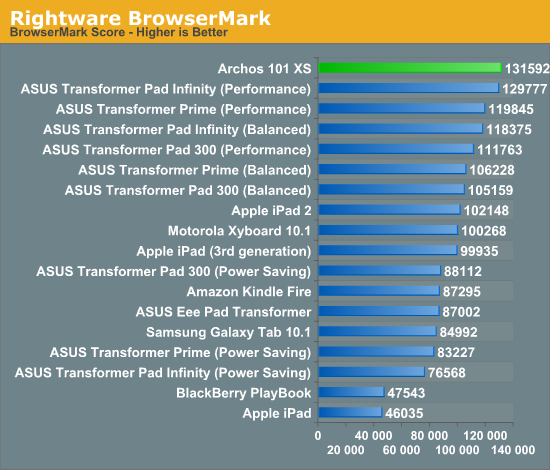
Browser performance is chart topping, beating both the new iPad and the lot of Tegra 3-equipped Transformers. I’ve always been a bit frustrated with browser performance test, their results on similar hardware have such a tendency to vary as to make me believe the results are contrived by the OEM. But that’s typically when a device bests the rest in a single benchmark, while it languishes in the other. That doesn’t seem to be the case here.
But what about that GPU? Let’s take a look at a chart so old, I can hardly bear it.
| Mobile SoC GPU Comparison | |||||||||||
| Adreno 225 | PowerVR SGX 540 | PowerVR SGX 544 | PowerVR SGX 543MP2 | Mali-400 MP4 | GeForce ULP | Kal-El GeForce | |||||
| SIMD Name | - | USSE | USSE2 | USSE2 | Core | Core | Core | ||||
| # of SIMDs | 8 | 4 | 4 | 8 | 4 + 1 | 8 | 12 | ||||
| MADs per SIMD | 4 | 2 | 4 | 4 | 4 / 2 | 1 | 1 | ||||
| Total MADs | 32 | 8 | 16 | 32 | 18 | 8 | 12 | ||||
| GFLOPS @ 200MHz | 12.8 GFLOPS | 3.2 GFLOPS | 6.4 GFLOPS | 12.8 GFLOPS | 7.2 GFLOPS | 3.2 GFLOPS | 4.8 GFLOPS | ||||
| GFLOPS @ 300MHz | 19.2 GFLOPS | 4.8 GFLOPS | 9.6 GFLOPS | 19.2 GFLOPS | 10.8 GFLOPS | 4.8 GFLOPS | 7.2 GFLOPS | ||||
The SGX544 is effectively half of the GPU we saw in the iPad 2, the only difference between the SGX543 and 544 being Direct X designations. GPU clocks in the iPad 2 were far more conservative, though, than the 384 MHz we see in OMAP 4470. When Brian looked over TI’s claims he found some rationale for their claim that their SGX544 performance would be 2.5x the SGX540 it replaces. As it turns out, that’s almost exactly the case in some of our tests.
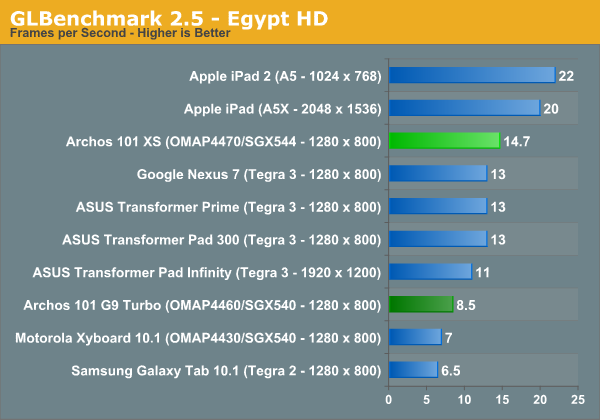

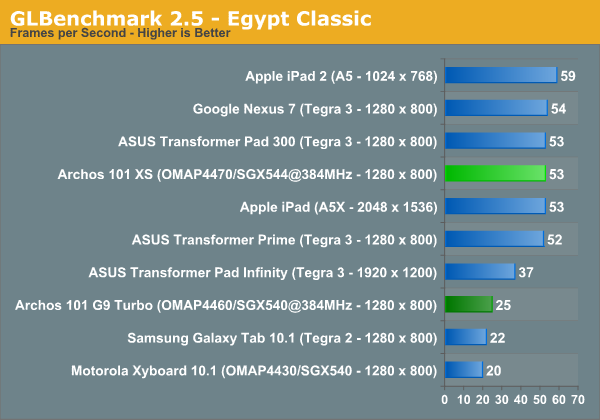
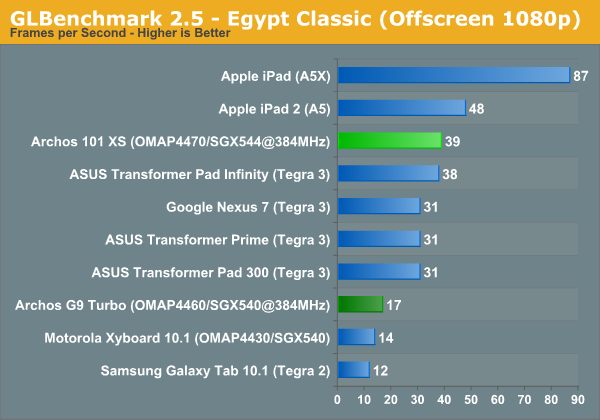
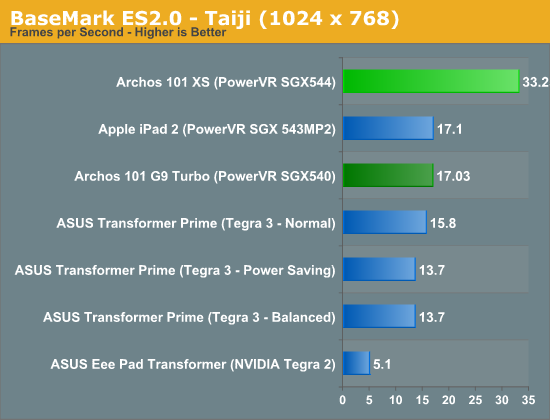
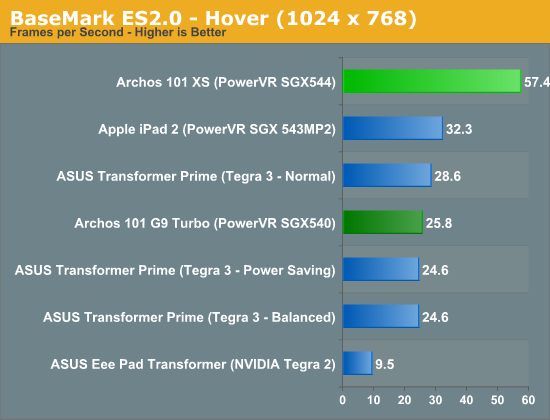
Where the G9s weren’t able to rise above the pack in some of our tougher GPU tests, the XS stays firmly planted at or near the top of all of our GPU tests. And despite being a single core to the iPad 2’s dual core GPU the ~12.3 GFLOPS bestowed on this SGX544 keeps it competitive with the iPad 2, particularly in the off-screen tests.
When Apple debuted the A5 they set the mold for future mobile SoCs, where a big GPU, complimented by hardware accelerated UI composition, would be integral to a great user experience. Samsung seemed to have picked up on this idea, packing the impressive Mali-400 MP4 into its Exynos 4xxx offerings. Qualcomm and TI have been a little later to this game, ramping up clockspeeds and doing some minor architectural tweaks to eke out as much performance as they could out of their last gen GPU architectures, Adreno 2xx and SGX54x, respectively. The good news is that each has been able to get quite a lot out of these older parts; the bad news is that a lot more power is right around the corner. So while the XS GPU performance is chart topping, that status is likely to be short-lived. But does it really matter?
Within the PC space the Atom and Core 2 era of processors defined a ‘good enough’ standard that persists somewhat to this day. While there are certainly performance and feature gains in a modern Core i5 to justify upgrading from a Core 2 era CPU, for the vast majority of users, a decent Core 2 will be enough; and some may even do fine with an Atom based system. We seem to be reaching this inflection point in the tablet space. The real world difference between two given Android devices has more to do with the software than the actual hardware inside. If you don’t believe me, go find an International SGS III variant, with Samsung’s cutting edge and stonking Exnos 4 Quad inside, and compare it alongside a Galaxy Nexus running Jelly Bean. The latest edition of Android pushes the relatively modestly powered Nexus well past the quad-core SGS III where it matters most, smooth UI performance. And while the beefier GPU and extra cores may help the Exynos 4 Quad when resolutions climb past 720p, it’s memory bandwidth that’s the real bottle neck there today, so the advantage won’t be fully realized until Android sees a SoC that focuses on that issue, a la Apple’s A5X.
What Archos has done is, I believe, set the bar past ‘good enough,’ and planted it firmly in the performance realm. Truth be told, we weren’t expecting much from the OMAP 4470; it just felt antiquated by technology standards. But solid hardware and a focused approach in software to draw out as much performance as the silicon would allow has very nearly won the 101 XS the title of World's Fastest. It's certainly far in excess of our expectations.


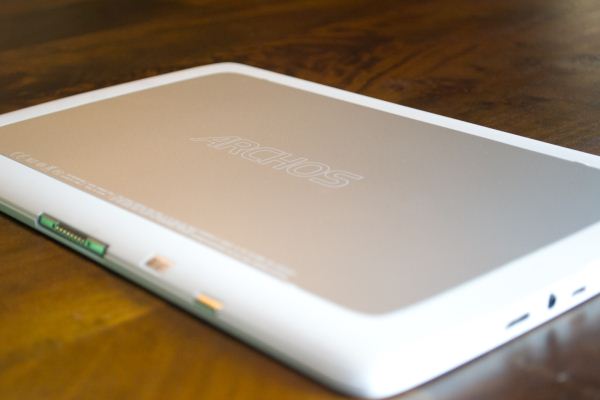








44 Comments
View All Comments
aryonoco - Wednesday, August 22, 2012 - link
Hi Jason,Fine article, but there were a few grammatical errors in your piece that shouldn't have gone beyond your editor:
"the kind of codec support that many of todays popular tablets" should be "today's popular tablets".
"Archos has worked to tweak there Android" should be "their Android"
"does not extend to the stock player, only Archos own player" should either be "Archos' own player" or "Archos's own player" (depending on which style guide you follow).
Thanks
JasonInofuentes - Thursday, August 23, 2012 - link
Missed a few others, yourself. I'll try and catch the rest before you do. Cheers.Jason
rarson - Wednesday, August 22, 2012 - link
in the AnandTech comments section.JasonInofuentes - Thursday, August 23, 2012 - link
If any of you guys are professional commenters let me know. :)Charbax - Wednesday, August 22, 2012 - link
Archos 101 XS with keyboard: $399Asus Transformer Pad TF300 with keyboard: $529 (+33%)
Acer Iconia Tab A700 with keyboard: $599 (+50%)
Asus Transformer Prime with keyboard: $649 (+63%)
iPad3 with keyboard: $599 (+50%)
Samsung Galaxy Note 10.1 with keyboard: $599 (+50%)
Microsoft Surface with keyboard: $599 (likely) (+50%)
I think Archos likely will release a firmware to fix the power consumption for video and games. Also consider video games need to be fully optimized for SGX544 before they can perform as well as for example on Tegra3. This is likely happening faster than some would think, I think OMAP4470 is going to win Q4 2012 just as OMAP4430/4460 won Q4 2011 (Galaxy Nexus, Kindle Fire, Nook Tablet, Motorola Razr/Atrix2 etc..) I expect OMAP4470 is the platform in upcoming Galaxy Nexus Superior, Kindle Fire 2, likely also the next range of Motorola, LG and some other Samsung devices among other. The more devices means the better software optimizations Archos can automatically get for Android features also. OMAP4 pretty much is the reference design for ICS and JB, this is likely to continue even as Google "opens up" to all other SoCs and manufacturers with the PDK.
voss,seal - Thursday, August 23, 2012 - link
I followed your "advice" on the previous Archos model. So I bought it, I'm in the process of returning my third Archos 101 - in a period of four months - because of touchscreen failures. I'd rather pay more for a functioning tablet.JasonInofuentes - Thursday, August 23, 2012 - link
I'm truly sorry you had a bad experience with the G9s. There's one thing that's much harder for us to report on than simply discussing our experiences with a given device: longterm durability. Build quality is a hurdle that Archos has to address, along with improving the turn around time for repairs or replacements.I think one issue is that very few of these devices end up our daily drivers, even if the review samples stay with us for a while so that we can follow up on software updates. Part of that, is that many of us don't have a reason to have a daily driver tablet. Readers that have followed our iPad coverage probably recall that almost every review features a section bemoaning the extent to which the prior generation has remained in a drawer, unused. The tablet isn't yet an essential device. It's nice to have, and I enjoy using whatever I have on hand to watch videos and play the occasional game. But it's not part of my daily life.
In the meanwhile, I do apologize you've had as much trouble with failures. In the future, whether we recommended it to you or not, please let us know when a product you've bought has hit 'lemon' status. We appreciate the feed back.
Jason
Charbax - Friday, August 24, 2012 - link
I don't know what kind of problem voss thinks he has had. I've been using Tablets nearly every single day since February 2005. Initially the 3.5" Archos PMA400 with Qtopia Linux apps and WiFi tethering then already. Then other and only Archos devices with few Chinese cheap tablets to test. Since September 2010, every day I use the Archos 70 Internet Tablet when I go outside, it fits my jacket pocket. I upgraded it to Archos 70b Internet Tablet in January and I've been testing a few ICS soon Jelly Bean $50 tablets from Shenzhen since April, of course all those are 7" or smaller so that I can bring them with me every time I go outside, use them every time I'm in a bus or train or airplane, the 7" Tablet is just so much better than a phone size as it fits 2x to 3x more screen surface area, better for web browsing, better for apps, games, video playback (catching up all recorded/downloaded TV to not have to watch TV only at home) etc. This Archos 101 XS I think may allow me to use 10.1" for the first time as a laptop replacement. I could have spent $830 on a Transformer Prime with keyboard and Fry's Taxes in Las Vegas 8 months ago, but I did not want to pay that much, I thought it totally ridiculous to pay that much for an ARM Powered Laptop, those aren't supposed to cost nearly as much as an Ultrabook. I even think $400 for Archos 101 XS is still expensive, but when you compare with the competition, it's 33% to 63% cheaper. Sure enough, at $299 with keyboard I think the Archos 101 XS should be a huge fenomenon and everyone considering a 10" tablet or netbook/ultrabook should then consider it. Especially if/when Android gets optimized for Laptop/Desktop use, with some new "Desktop Mode" in Android, perhaps Google should just release such a Home Replacement that re-arranges things a bit optimized for Laptop Productivity, re-optimizing Chrome on Android just a bit so it's exactly like Chrome on any Laptop/Desktop, and also an app like Ubuntu on Android would be awesome for productivity. I'm waiting to see if Archos and TI can fix the governors to make sure battery life on its 6000mAh battery really is above 10 hours. And I'm looking forward to see if I can use Archos 101 XS to replace my $1000 Toshiba z830 ultrabook for most of my on-the-move Laptop productivity usage.tbutler - Friday, August 24, 2012 - link
I'm also concerned about build quality; the one other review I've seen on the 101 XS so far (the Verge one) cited significant issues there, especially with the screen. From the description, it sounded like they didn't use enough protection for the LCD panel, so you get typical LCD-pressure distortions when you put pressure on the screen from the front *or* back. Doesn't sound too encouraging to me.Spunjji - Thursday, August 23, 2012 - link
If OMAP4 is the reference for JB, why was the first JB device based on Tegra 3?The likelihood of a Q4 "win" for it looks unlikely given the probable arrival of at least one A15-based device by then, alongside proper SnapDragon S4 quad-core devices.